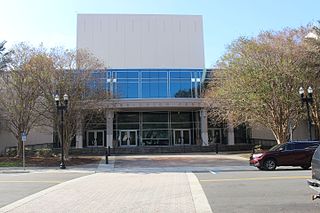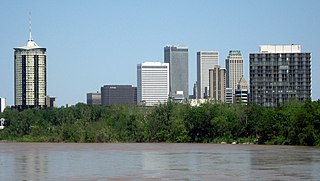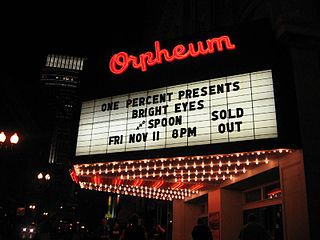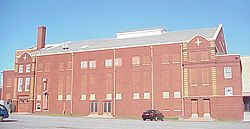
Bob Carr Theater is an auditorium located in Orlando, Florida. Opening in 1927, the venue is currently owned by the City of Orlando and in 2013, the site was integrated into the Creative Village Development plan.

Municipal Auditorium is a multi-purpose facility located in Kansas City, Missouri. It opened in 1935 and features Streamline Moderne and Art Deco architecture and architectural details.

The Philadelphia Convention Hall and Civic Center, commonly known simply as the Philadelphia Civic Center, was a convention center complex located in Philadelphia, Pennsylvania. It developed out of a series of buildings dedicated to expanding trade which began with the National Export Exhibition in 1899. The two most significant buildings in the complex were the original main exhibition hall built in 1899, which later housed the Philadelphia Commercial Museum, and the Municipal Auditorium, later called the Convention Hall, which was built in 1931 to the designs of architect Philip H. Johnson. The site was host to national political conventions in 1900, 1936, 1940 and 1948.

The Charleston Coliseum & Convention Center is a municipal complex located in the downtown area of Charleston, West Virginia, United States. Originally completed in 1958, it consists of four main components: the Coliseum, the Theater, the Auditorium, and the Convention Center.

Mobile Civic Center is a multi-purpose facility located in Mobile, Alabama. Owned by the City of Mobile and operated by ASM Global, the facility consists of three venues: a theater, an expo hall, and an arena. It is suitable for large indoor events including sporting events and trade shows. The theater seats for 1,938, while the expo hall can seat 3,000. The largest venue of the Mobile Civic Center is the arena, which can seat 10,112.

The Chicago Theatre, originally known as the Balaban and Katz Chicago Theatre, is a landmark theater located on North State Street in the Loop area of Chicago, Illinois. Built in 1921, the Chicago Theatre was the flagship for the Balaban and Katz (B&K) group of theaters run by A. J. Balaban, his brother Barney Balaban and partner Sam Katz. Along with the other B&K theaters, from 1925 to 1945 the Chicago Theatre was a dominant movie theater enterprise. Currently, Madison Square Garden, Inc. owns and operates the Chicago Theatre as a 3600 seat performing arts venue for stage plays, magic shows, comedy, speeches, sporting events and popular music concerts.

Buffalo City Hall is the seat for municipal government in the City of Buffalo, New York. Located at 65 Niagara Square, the 32-story Art Deco building was completed in 1931 by Dietel, Wade & Jones.
The Ellie Caulkins Opera House is located in Denver, Colorado as part of the large Denver Performing Arts Complex. It seats 2,225. The Caulkins family pledged $7 million towards the enhancement of the lyric opera house and adjacent public spaces which were constructed inside of the Newton Auditorium.
Denver Auditorium Arena was an indoor arena located at the corner of 13th and Champa Streets in Denver, Colorado. It was constructed as the Denver Municipal Auditorium in 1908 during the administration of Mayor Robert W. Speer. The building was opened on July 7, 1908, and was the site of the 1908 Democratic National Convention.

The San Jose Civic is a former arena, currently operating as a theatre and concert venue, located in downtown San Jose, California. The venue is owned by the City of San Jose, is managed by Team San Jose and is booked by Nederlander Concerts. The auditorium seats 3,036 which can be expanded up to 3,326 in a general admission setting.

The Jacksonville Center for the Performing Arts (JCPA) is a performing arts center located in Jacksonville, Florida. Situated along the Riverbank, the venue is known as the First Coast’s "premiere riverfront entertainment facility". Originally opening in 1962, the facility was renovated beginning in 1995 until 1997; with a grand re-opening on February 8, 1997. The center consists of three venues: a theatre; concert hall and recital hall. It is home to the Jacksonville Symphony, Jacksonville Symphony Youth Orchestra, and the FSCJ Artist Series.

Tulsa is the second-largest city in the state of Oklahoma. It has many diverse neighborhoods due to its size.

The Detroit Masonic Temple is the world's largest Masonic Temple. Located in the Cass Corridor neighborhood of Detroit, Michigan, at 500 Temple Street, the building serves as a home to various masonic organizations including the York Rite Sovereign College of North America. The building contains a variety of public spaces including three theaters, three ballrooms and banquet halls, and a 160 by 100 feet clear-span drill hall.

The Stifel Theatre is a civic performing arts building located in St. Louis, Missouri.

The Orpheum Theater is a theater located in Omaha, Nebraska. The theater hosts programs best served by a more theatrical setting, including the Omaha Performing Arts Broadway Season, presented with Broadway Across America, and Opera Omaha's season. The theatre is listed on the National Register of Historic Places. The main auditorium is a proscenium theater known as "Slosburg Hall". The theater has a theatre organ, made by Wurlitzer.
Downtown Tulsa is an area of approximately 1.4 square miles (3.6 km2) surrounded by an inner-dispersal loop created by Interstate 244, US 64 and US 75. The area serves as Tulsa's financial and business district; it is the focus of a large initiative to draw tourism, which includes plans to capitalize on the area's historic architecture. Much of Tulsa's convention space is located in downtown, such as the Tulsa Performing Arts Center and the Tulsa Convention Center, as well as the BOK Center. Prominent downtown sub-districts include the Blue Dome District, the Tulsa Arts District, and the Greenwood Historical District, which includes the site of ONEOK Field, a baseball stadium for the Tulsa Drillers opened in 2010.

The Ulster Performing Arts Center (UPAC), originally the Broadway Theater and Community Theatre, is located on Broadway in Kingston, New York, United States. A Classical Revival building built in 1926, it is the only unaltered pre-World War II theater left in the city, and one of only three from that era in the Hudson Valley. It is also the largest proscenium theater between Manhattan and Albany.

The Music Hall at Fair Park is a performing arts theater in Dallas, Texas's Fair Park that opened in 1925.
The following is a timeline of the history of the city of Tulsa, Oklahoma, United States.
















